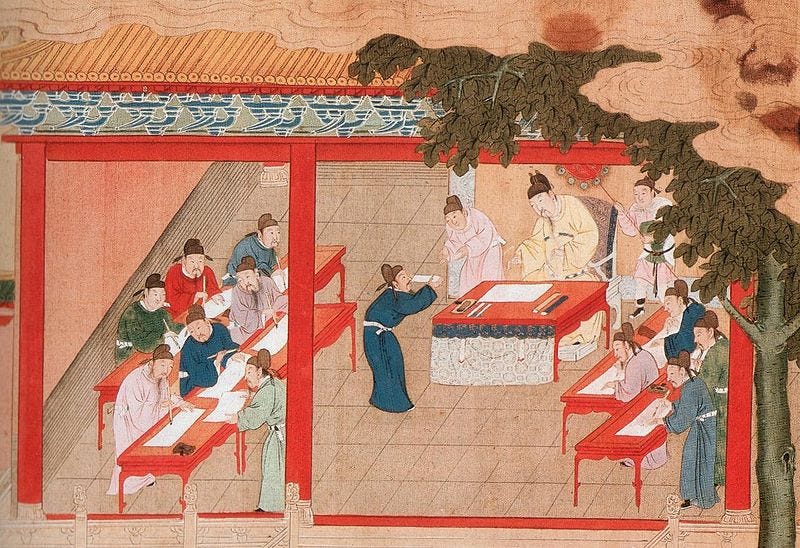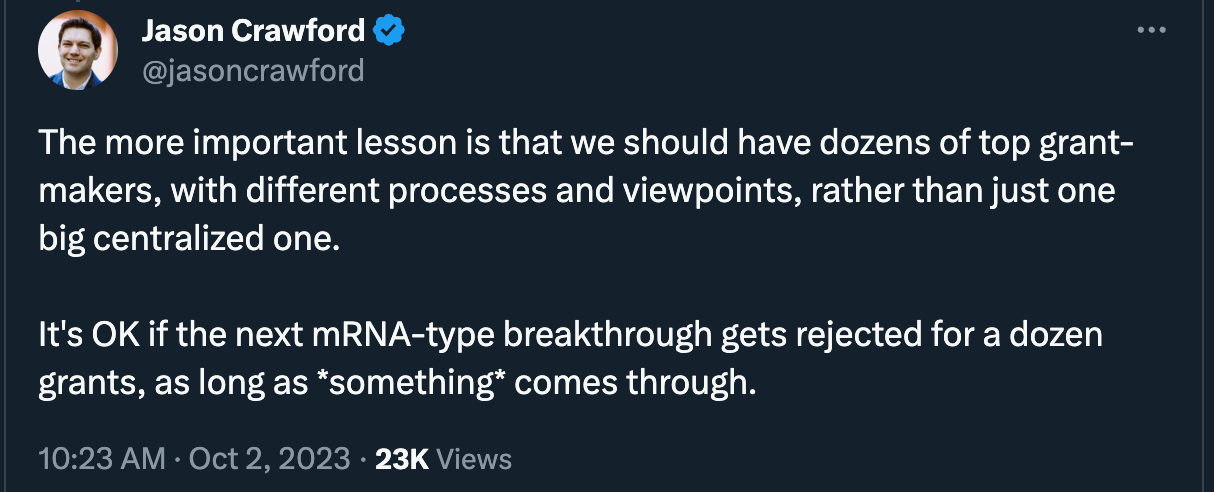
This is my second post for the Roots of Progress blog building fellowship. I’d love any constructive feedback on this or any other recent pieces! -Connor
Think of a society as a kind of investment portfolio of talent.
In capitalist economies, people are free to choose their paths, guided by market prices. Over time, this type of “portfolio” has far out-earned all the rest in the form of explosive economic growth and innovation. Yet even in the freest societies, the interests and careers people pursue are inevitably influenced by mediating institutions, social pressures, and outright fads. We hope–but are never sure–that enough of our best and brightest are working on the kinds of problems that really matter.
On October 2, we were reminded that even a purportedly well-balanced portfolio can indeed be fragile, subject to “black swan” failures of oversight or groupthink. On that day, Katalin Kariko was awarded the Nobel Prize in medicine for path-breaking work on mRNA technology that yielded highly effective Covid-19 vaccines. Her and her collaborators’ research may just mark the beginning of a new era of treatments for diseases ranging from malaria to cancer, with the potential to save tens of millions of lives.
Yet Katalin Kariko was ignored by mainstream science. For three decades, she bounced from one lab to another with little job stability and meager pay. Today we have the mRNA vaccines that saved so many lives mostly because of her dogged refusal to take “no” for an answer. The National Institutes of Health, the body that dominates biomedical research grantmaking, simply did not take her ideas seriously for many years. The issue was not inadequate funding to go around, but insufficiently diverse perspectives in the grantmaking ecosystem. As Jason Crawford points out in a Twitter thread, there are few outside sources of funding in Kariko’s field beyond the NIH. He ends with this:

The failure of the NIH to spot the potential of mRNA technology is itself interesting, but even a well-designed central grantmaking body is inevitably going to miss some breakthroughs. Single institutions are always going to have internal cultures with biases or flaws. The key is to have a diverse body of grantmaking organizations with differing perspectives.
In other words, we need to hedge our bets.
The Kariko saga raises not only important questions about how we fund biomedical research in the United States, but how we allocate talent across society. For our smartest students, budding academics, or researchers, are there enough pathways and funding sources to prevent a Kariko in another critical field from being ignored? Few seem to be asking this question.
Institutional pluralism and diversity of perspective aren’t exactly compelling rallying cries, but there is potentially much more at stake here than having an effective Covid-19 vaccine. We ought to be more concerned that many dominant institutions in American society–particularly those through which nearly all of our most talented young people pass–tend to think the same way, whether on politics, scientific claims, or moral values.
It is worth dwelling upon a society that had extremely little institutional diversity, instead betting nearly all its most valuable human capital on a system that ended up being immensely hostile both to freedom and technological progress: imperial China.
How Chinese civil service exams squashed dissent–and an industrial revolution
The Keju civil service examination system’s purpose was first and foremost political control. Established under the Sui Dynasty in the sixth century, Keju exams would serve as the primary means of selecting government bureaucrats through the final days of the Qing Dynasty in the early 20th century. In a fascinating new book, The Rise and Fall of the EAST, MIT economic historian Yasheng Huang traces the effects of the Keju exam system on Chinese autocracy and attitudes towards change and technological progress through our current era.
The exams, Huang argues, were the fairest, most accessible means of upward mobility in imperial China. By pioneering double-blind grading schemes for local and provincial exams and cracking down on cheating, this system ensured that talented young Chinese subjects knew that if they worked hard enough, they could ascend the ladder of the Chinese state, enriching themselves and their families in the process. Huang writes:
As a method for controlling society, Keju was extremely advanced for its time. The route to success and the path for preparation were laid out clearly for participants. The metrics were unambiguous and delineated, and in modern marketing language Keju had a deep channel penetration—it was accessible to all of the cross-sections of society, including its lowest rungs. All else being equal—and often all else was stacked in favor of Keju in any case—a rational person would likely choose Keju over other career paths that yielded uncertain payoffs.
As the sponge that soaked up the vast majority of highly intelligent and motivated young people, the Keju-powered bureaucracy would direct the energies of the nation’s top talent toward the preservation of state power. Religious, commercial, or research institutions that could have been the source of economic or intellectual flourishing were instead starved of talent. The merit-based nature of selection added a hefty layer of legitimacy to an expansive and stifling bureaucracy. Keju would grow over time to diffuse threats to the imperial regime, to co-opt talent that might otherwise coalesce and push back on an authoritarian state, and to concentrate moral legitimacy in all-powerful emperors.
The material exam candidates were required to learn deeply enforced attitudes deferential to hierarchy, tradition, and state authority, all of which characterize China’s feeble civil society to this day. The core canon that ultimately emerged was based on Neo-Confucianism, which Huang described in the following terms:
Neo-Confucianism is more unabashedly autocratic and statist than original Confucianism. It exalted eliminating human desires and a complete subjugation of the self. Summarizing a common view among historians, Peter Bol observes that Neo-Confucianism “provided a justification for seeking external authority in the ruler” and stipulated that the emperor alone was responsible for transforming the world.
In other words, the material drilled into generations of elite bureaucrats was hostile to free thought and the relentless curiosity and skepticism that defined Enlightenment-era European intellectuals. This did not exactly yield fertile ground for an industrial revolution.
But for all the flack Confucianism gets for attitudes hostile to free thought and technological progress, these features were not necessarily the impetus for adoption. Other ideologies may very well have taken off as the basis for the exams instead. As Huang points out, the Confucian curriculum withstood long periods of rule by Buddhist and Daoist emperors. Why? He argues that the exams served as a kind of signaling device. With over 9,000 characters, the Confucian canon was far denser and more difficult than any potential alternatives. Students who made it through had to put in years of incredibly tedious work and rote memorization. Successful exam-takers proved more than just mastery of a particular school of thought; they also demonstrated a kind of dedication and loyalty that would yield dedicated yet servile bureaucrats.
It was only over centuries that the effects of pushing the country’s top talent through the Confucian ringer that its ideals became deeply ingrained in the attitudes of those who steered the state and society. The technological lead that China had over Western Europe at the turn of the last millennium would gradually become a gaping deficit. Generations of both liberal and revolutionary thinkers saw the downsides of hostility to modernizing but could do little to uproot it.
Echoes in modern academia?
We have no Keju exam system in the United States today, of course. Yet there seem to be many echoes of Keju in the status and signaling games that dominate the time and attention of talented young people today, particularly higher education. No, universities are hardly explicit tools of political control. But just as Keju monopolized nearly all of China’s top talent, most bright young Americans pass through traditional academia at some point during their formative years. Consider some of the other similarities.
Keju emerged primarily for instrumental reasons; the signal from passing one or more exams was useful for a state seeking deferential but capable bureaucrats. You had to be smart to digest a dense Neo-Confucian curriculum, but you also had to be dedicated and thorough. Today, economist Bryan Caplan and others compellingly argue that much of, or perhaps most of, the value of a college degree comes from the signaling it sends rather than the content it teaches students. The dramatic expansion of access to higher education arose after World War II for highly practical reasons, just like Keju. The values it imbued were merely incidental at first.
Modern academia certainly allows vastly more free thought than Keju, which militantly limited the scope of acceptable ideas. But the highly democratic elements of academia also means its scope of views and people permitted in its ranks is primarily consensus-based. If you are an outsider with few backers on the inside–perhaps one with an idea for an experimental technology that could change the world of vaccinations–you may struggle for funding or employment.
Finally, consider the finding that political and social attitudes in academia are converging on a particular brand of progressive thought. A small minority of professors at American universities even self-identify as conservatives. Campus wars break out routinely over guest speaker invitations, episodes which often end with universities caving to activist demands. The degrowth movement and its skepticism of economic growth and technological progress is one primarily led by elite academics. We should hardly be surprised if, over the long run, funneling nearly all of our best and brightest young people through this institutional monoculture will have major effects on how future generations of elites view the world.
One of the most popular ways to earn bipartisan plaudits in American politics is by promoting alternatives to four-year degrees. The costs are simply too high for a four-year degree to be worth it for the average student, critics say. But this may get the truth exactly backward. For the average student finishing his or her degree, college still pays handsomely, particularly at state schools. Tellingly, the kids of the elites who most decry universities may be those most certain to attend themselves.
Instead, we should be thinking more carefully about alternative pathways for our brightest minds, the “exit” in Albert Hirschaman’s Exit, Loyalty, and Voice framework. It is not necessarily the case that academia itself is broken per se, nor is it necessarily true that the NIH is hopelessly rotten. Rather, we may not have properly balanced our talent portfolio.
Relying on dominant institutions to cultivate and nurture talent–like holding an investment portfolio overwhelmingly made up of Ford stock–is an implicit bet that their worldview is correct. The biomedical research ecosystem is dominated by an NIH that was deeply skeptical of mRNA vaccines, nearly halting a revolution in medicine before it got started. The Chinese imperial bureaucracy bet heavily on a system that passed on values deeply skeptical of freedom and innovation; it is no coincidence that China remained mired in deep poverty long after the West.
Today, rather than create early pathways to independent research or entrepreneurship like the Thiel Fellowship or Emergent Ventures, the default is to send our smartest young people through traditional universities, where degrowth and illiberalism hold great sway. We’d be fools not to think this will shape the attitudes of future elites. Unless you think these institutions have got it exactly right, there may be more Katalin Karikos in our future.
This is a great piece! Thanks very much for posting.
Thank you!!